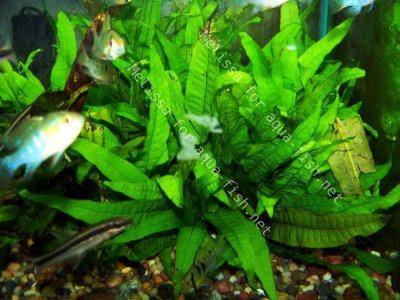Microsorium pteropus
Scientific name: Microsorium pteropus
Family: Polypodiaceae
Maximum size reached under cultivation: 20 - 25 cm (7.87 - 9.84 inch)
014
Recommended pH range: 5.5 - 7.5
Recommended water hardness: 4 - 15°dGH (71.43 - 267.86ppm)
0°C 32°F30°C 86°F
Recommended temperature range: 20 - 25 °C (68 - 77°F)
Preferred propagation method: Rhizome
Native to: South Asia
Growth rate: Slow
Recommended substrate: Fine gravel
Lighting requirements: Medium
Ideal placement in tank: Midground
Common Name
Java Fern
Origin
Microsorium pteropus, or Java Fern, originates from Southeast Asia, including countries such as Indonesia, Malaysia, and Thailand. It thrives in slow-moving and still freshwater environments like rivers, streams, and swamps, where it attaches itself to rocks, driftwood, and other submerged surfaces.
Growing Conditions
Microsorium pteropus is a versatile and hardy plant that can be grown fully submerged in aquariums or partially emersed in high-humidity environments, such as paludariums or near pond edges. It grows slowly and reaches an average size of 20 - 25 cm (7.87 - 9.84 inches). This plant prefers a pH range of 5.5 to 7.5 and moderate water hardness between 4 and 15 dGH. It thrives in temperatures between 20 - 25°C (68 - 77°F) and under medium lighting conditions.
Unlike many other aquarium plants, Java Fern should not be planted in the substrate. Instead, it should be attached to aquarium decor, such as rocks or driftwood. Using fishing line, thread, or plant glue, you can secure the rhizome to a surface until it anchors itself.
Planting Area
With its moderate size, Java Fern is ideal for the middle section of an aquarium. It adds texture and depth to the aquascape and pairs well with both taller background plants and smaller foreground species. Its hardy nature and low-maintenance requirements make it a favorite for aquariums housing herbivorous fish, as the tough leaves are often unappealing to them.
Propagation
Propagation of Microsorium pteropus is simple and often occurs naturally. Mature leaves will develop small plantlets along their edges. As these plantlets grow, they eventually detach and float freely in the tank until they find a suitable surface to attach to. For more controlled propagation, you can carefully remove the plantlets when they have a few small leaves and roots, then attach them to rocks or wood using fishing line or a rubber band until they anchor themselves.
Difficulty
Microsorium pteropus is considered easy to care for, making it an excellent choice for both beginner and experienced aquarists. It is highly adaptable to various water conditions and can thrive in low-tech setups without CO2 injection or high-intensity lighting.
Short Description
The Java Fern is a hardy and low-maintenance plant that adds a unique touch to any aquarium with its lush, green leaves. It thrives in a range of water conditions, making it suitable for various setups. The plant’s tough leaves are rarely eaten by fish due to their unpalatable taste, making it a perfect addition to tanks with herbivorous species. Easy to propagate and grow, Java Fern is a popular choice among aquarists who seek an attractive and durable plant that requires minimal care.


